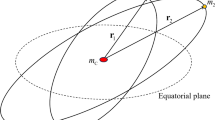Abstract
This paper presents quantitative estimates of orbital lifetimes for small dust particles in the vicinity of a spherical asteroid orbiting the Sun on a circular orbit. In particular, the modeling accounts for gravitational interactions with the asteroid and the Sun and radiation pressure from the Sun. The analysis focuses on slow drift of particles in a state-space neighborhood of weakly unstable periodic orbits corresponding to the most tightly bound orbits about the asteroid. Through a Hamiltonian normal-form computation, Nekhoroshev-type estimates are derived that yield regions in state space of effective stability, that is, regions in which the grains would remain over significant periods of time in the absence of other depletion and replenishment mechanisms.
Similar content being viewed by others
References
Burns, J. A., Lamy, P. L. and Soter, S.: 1979, 'Radiation forces on small particles in the Solar system', ICARUS 40, 1–48.
Chamberlain, J. W. and Bishop J.: 1993, 'Radiation pressure dynamics in planetary exospheres, II. Closed solutions for the evolution of orbital elements', ICARUS 106(2), 419–427.
Dankowicz, H.: 1994, 'Some special orbits in the two-body problem with radiation pressure', Celest. Mech. & Dyn. Astr. 58, 353–370.
Dankowicz, H.: 1995, 'The two-body problem with radiation pressure in a rotating reference frame', Celest. Mech. & Dyn. Astr. 61(3), 287–313.
Dankowicz, H.: 1997a, 'Escape of particles orbiting asteroids in the presence of radiation pressure through separatrix splitting', Celest. Mech. & Dyn. Astr. 67(1), 63–85.
Dankowicz, H.: 1997b, Chaotic Dynamics in Hamiltonian Systems; with Applications to Celestial Mechanics, World Scientific Publishing Co. Pte. Ltd.
Delshams, A. and Gutierrez, P.: 1996, 'Effective stability and KAM theory', J. Differ. Eq. 128, 415–490.
Dermott, S. F., Durda, D. D., Gustafson, B. Å. S., Jayaraman, S., Xu, Y. L., Gomes, R. S. and Nicholson, P. D.: 1992, 'The origin and evolution of the zodiacal dust cloud', In: A. W. Harris and E. Bowell (eds), Asteroids, Comets, Meteors 1991, Lunar and Planetary Institute, 153–156.
Dermott, S. F., Durda, D. D., Gustafson, B.Å. S., Jayaraman, S., Liou, J. C. and Xu, Y. L.: 1994, 'Zodiacal dust bands', In: A. Milani, M. Di Martino and A. Cellino (eds), Asteroids, Comets, Meteors 1993, Kluwer Academic Publishers, pp. 127–142.
Dermott, S. F., Grogan, K., Holmes, E. and Kortenkamp, S.: 1999, 'Dynamical structure of the zodiacal cloud', In: J. M. Greenberg and A. Li (eds), Formation and Evolution of Solids in Space, Kluwer Academic Publishers, pp. 565–582.
Durda, D. D. and Dermott, S. F.: 1997, 'The collisional evolution of the asteroid belt and its contribution to the zodiacal cloud', ICARUS 130(1), 140–164.
Grogan, K., Dermott, S. F., Jayaraman, S. and Xu, Y. L.: 1997, 'Origin of the ten degree Solar System dust bands', Planetary Space Sci. 45, 1657–1665.
Gustafson, B. Å. S.: 1989, 'Geminid meteoroids traced to cometary activity on phaethon', Astron. Astrophys. 225, 533–540.
Gustafson, B. Å. S., Dermott, S. F. and Xu, Y. L.: 1999, 'Forces on dust in interplanetary space', In: A.-C. Levasseur-Regourd, (ed.), Asteroids, Comets, Meteors, 1996, Kluwer Academic Publishers, pp. 245–254.
Hamilton, D. P. and Burns, J. A.: 1992, 'Orbital stability zones about asteroids. II. The destabilizing effects of eccentric orbits and of solar radiation', ICARUS 96, 43–64.
Jorba, A. and Villanueva, J.: 1998, 'Numerical computations of normal forms around some periodic orbits of the restricted three body problem', Phys. D 114, 197–229.
Lukyanov, L. G.: 1984, 'Coplanar solutions in the photogravitational restricted, circular three-body problem', Sov. Astron. 28, 462–465.
Lukyanov, L. G.: 1986, 'Stability of Lagrangian points in the restricted, photogravitational three body problem', Sov. Astron. 30, 720–724.
Mignard, F.: 1982, 'Radiation pressure and dust particle dynamics', ICARUS 49, 347–366.
Mignard, F. and Henon, M.: 1984,'About an unsuspected integrable problem', Celest. Mech. & Dyn. Astr. 33, 239–250.
Mukai, T., Blum, J., Nakamura, A. M., Johnson, R. E. and Havnes, O.: 2001, 'Physical processes on interplanetary dust', In: E. Gr¨un, B. Å. S. Gustafson, S.F. Dermott and H. Fechtig (eds), Interplanetary Dust, Springer Verlag, pp. 445–508.
Veeder, G. J., Hanner, M. S., Matson, D. L., Tedesco, E. F., Lebofsky, L. A. and Tokunaga, A.: 1989, 'Radiometry of near-earth asteroids', Astron. J. 97, 1211–1219.
Whipple, F. L.: IAU circular No. 3881.
Author information
Authors and Affiliations
Rights and permissions
About this article
Cite this article
Dankowicz, H. Slow Diffusion and Effective Stability of Dust Particles Orbiting Asteroids. Celestial Mechanics and Dynamical Astronomy 84, 1–25 (2002). https://doi.org/10.1023/A:1019966826421
Issue Date:
DOI: https://doi.org/10.1023/A:1019966826421




